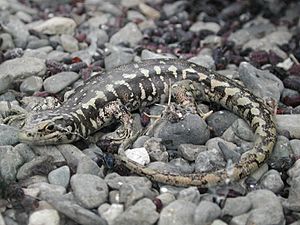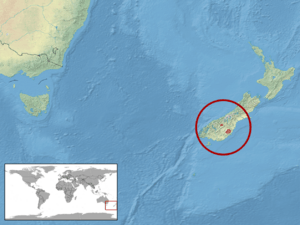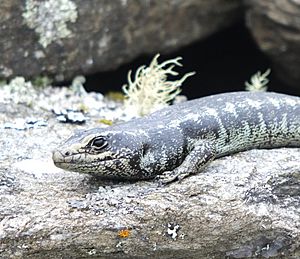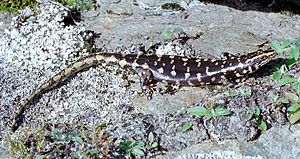Otago skink facts for kids
Quick facts for kids Otago skink |
|
|---|---|
 |
|
| Conservation status | |
| Scientific classification | |
| Genus: |
Oligosoma
|
| Species: |
otagense
|
 |
|
| Synonyms | |
|
|
The Otago skink (Oligosoma otagense) is a large, rare skink found only in Central Otago, New Zealand. It is an endangered species, meaning it is at high risk of disappearing forever. These skinks live among rocky canyons and grassy areas.
Physical Features and Life Cycle
Otago skinks are quite big for New Zealand skinks. They can grow up to about 30 centimeters (12 inches) long. They have unique black, yellow, and green spots. These spots help them blend in perfectly with the rocks covered in lichen and other plants. This blending in is called camouflage. Young skinks are more yellow with dark patches.
Like most skinks, Otago skinks are omnivores. This means they eat both plants and animals. Their diet includes many different insects, juicy fruits, flower petals, and sometimes even other small reptiles.
These skinks live a long time. They can live for about 16 years in the wild. In zoos, some have lived for up to 40 years! They also grow up slowly, becoming ready to have babies at 3 to 4 years old.
Unlike many reptiles that lay eggs, Otago skinks are viviparous. This means the babies grow inside the mother's body. The mother then gives birth to live young. Usually, one to three babies are born between January and March.
Where Otago Skinks Live
Otago skinks are found in only a few special places in Otago. Most of them live in eastern Otago, between Macreas Flat and Sutton. They are usually found at heights of up to 1,000 meters (about 3,300 feet). There is also a smaller group in western Otago, between Lake Hāwea and Lindis Pass. Their total home area is about 2,227 square kilometers (860 square miles).
These skinks mostly live on large rock formations called schist outcrops. You can often see them warming themselves in the sun on these rocks. This helps them control their body temperature. When they are scared, or when it's cold or night, they hide in deep cracks in the rocks.
Over the last 100 years, the area where Otago skinks live has shrunk by about 90%. This is mainly because of changes in how land is used. More farms have been created, and new animals that hunt skinks have been brought in.
Protecting the Otago Skink
The IUCN has listed the Otago skink as Endangered. This is because they live in a very small area and there are not many of them left. In New Zealand, the Department of Conservation (DOC) calls the Otago Skink "Nationally Critical." This is the highest threat level. Scientists are always working to find ways to protect them.

Most of the dangers to the skinks come from human activities. Farming and mining have taken away much of their natural home. This also removes their food and places to hide. Also, new animals like house cats, rabbits, ferrets, and weasels were brought to New Zealand. These animals hunt the skinks. Skinks were not used to these types of hunters, so they were greatly affected.
Because skinks have few babies and grow up slowly, it's hard for their numbers to increase. They also need a very specific type of home. This means the groups of skinks are small and separated. It's hard for them to move to new places or for their populations to grow.
People are working hard to save the Otago skink. They are protecting their homes and building fences to keep predators out. They also control the number of predators. These efforts have been successful, and skink numbers are slowly going up.
The Otago skink is fully protected by New Zealand law. DOC wants to keep protecting them in their natural homes. However, some skinks are also raised in zoos and special centers. This helps make sure the species survives if something bad happens in the wild. While it was once thought the skink might disappear completely, protection efforts have made this less likely. Still, the species is still at risk.



